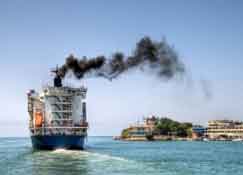Nearly 200 nations at the UN Climate Summit in Paris committed to reducing their country's CO2 emissions to varying degrees.
Around the world, thousands of companies have launched their own programs to reduce greenhouse gas emissions, often more aggressively than the pledges from the countries where they operate. Indeed, when President Trump said earlier this year that the US would not abide by the UN agreement, the CEOs of many US companies vowed to move ahead as if the commitments were still in place.
And of course supply chain is at the forefront of many of those corporate programs. To cite just one of many examples, in April, Walmart announced what it calls Project Gigaton, named that way because that's how many metric tons of CO2 it wants eliminate from its total supply chain by 2030 – largely by working with suppliers to find ways to reduce their emissions.
But one area of the global supply chain is not on board yet with CO2 reduction: the ocean shipping industry.
In fact, there was really no mention of ocean carriers in the Paris Climate Accord, and the sector does not appear to be targeted by individual country initiatives, most likely because the carriers are sort of independent of country, emitting most of their CO2 while toiling international waters, out of sight and to an extent out of mind.
It's not as if no one has noticed. The issue periodically makes its way into the press, and the European Union especially from time to time threatens to take some action – though it is not clear what those actions would be. It has made calls at least for more detailed reporting by carriers.
But it involves a lot of emissions. Most large container and bulk ships run on what is called bunker fuel, an oil-based product considered very dirty and which emits a lot of CO2 as it is burned.
The International Maritime Organization (IMO) says sea shipping makes up around 3% of global CO2 emissions – though in fairness given their huge cargos the emissions per ton mile are pretty low compared to most other transportation modes. Still, the absolute level of emissions is high – and growing.
A recent article in Grist magazine claimed that "Experts say regulatory action and big, bold investments will be essential to curbing the shipping industry's contribution to global warming. Left unchecked, its carbon footprint is expected to soar in coming decades - just as emissions from cars and power plants flatline or decline. That means shipping could cancel out progress in other sectors."
Grist claims for now at least shipping companies have little incentive to change the status quo. They can also point to ever larger and more efficient megaships that can hold 20,000 TEU and thus move more freight per gallon of bunker fuel burned than previous smaller ships.
But some others are taking action. For example, in January the Panama Canal launched a program to reward shippers that meet high energy-efficiency standards or use low-sulfur and lower-carbon fuels, including cleaner-burning liquefied natural gas. Companies that do so can boost their standing in the Canal's ranking system for determining which ships gets priority access to the waterway.
 But it is not clear that the program is really having any real effect. But it is not clear that the program is really having any real effect.
What, if anything, can be done? The Grist article says the most prominent options for powering a ship without fossil fuels include hydrogen, batteries, sustainably produced biofuels, and wind-assisted technologies that can reduce fuel use.
In the shorter term, use of a natural gas-based fuel could reduce the emissions sharply versus that which comes from bunker fuel.
Some environmentalists are calling for major tax increases on bunker fuel to push the move by ship builders and carriers much faster than is happening now.
The industry is taking some action. There are on-going tests of all of the alternative fuel possibilities mentioned above. What's more, feeling pressure, the IMO plans to adopt an interim strategy for reducing greenhouse gases caused by shipping in April 2018. But the regulatory body doesn't expect an agreement on actual pollution targets by its 172 member countries until at least 2023.
But it could be the companies hiring the carriers for ocean shipping that in the end have the most leverage, since it's their money that makes the industry go. But will shippers apply real pressure? And there is a bit of a chicken and egg problem, as it would be hard for shippers to apply their leverage if there aren't many ships using low CO2 approaches - and will be challenging even if there were if the costs are higher than the current approaches.
"For shipping to play its part in fighting climate change, vessels traversing the world's waters will need a more radical redesign - and in just a few decades' time,"
Grist concludes.
Are emissions from ocean carriers a major concern? What should be done to address the issue? Let us know your thoughts at the Feedback button below.

|